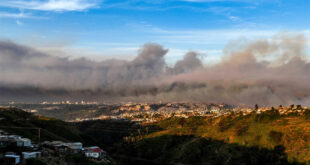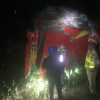One afternoon in mid-July Major Nguyen Van Son was going through a stack of documents pertaining to Vietnamese soldiers who died in Laos during the war.
He stumbled upon the picture of an unnamed grave and tears welled up in his eyes.
There were so many soldiers who fell in Laos. Some were identified and their remains were returned to their families, but many had their names lost to the past. It was the job of Son, an official at the Ha Tinh Military Command, to bring them back home.
The dry seasons are unforgiving in Laos, with a scorching sun and gusts of hot air. But they are also the best time to find the remains of lost soldiers since there are few asphalt roads in Laos and rains prevent vehicles from going uphill.
Son’s team organizes an expedition each every year to two Lao localities, Bolikhamsai and Vientiane. One lasts from October to January and the other from February to mid-May.
The teams are split into smaller ones with six to eight members in each. They usually return home for the Lunar New Year, but since Covid-19 broke out they have remained in Laos and only returned during the rainy season.
A search for remains begins with an analysis of tactical maps created by Vietnamese soldiers in the past to figure out possible grave locations, and also through the gathering of information from both Vietnamese and Lao veterans and locals who were in the war.
Fighters participating in the Lao Civil War can also be a source of information, but they are often difficult to approach and uncooperative.
A team from the Ha Tinh Military Command searches for grave sites of Vietnamese soldiers who died in Laos during the war. Video by VnExpress/Duc Le
Before each search, Son’s team gather all available information, including possible grave sites, and then draw up a detailed plan for a full six months.
New team members enroll in elementary Lao language courses for around two months for communication purposes.
Son said: “Information about the locations of grave sites is only approximate. For greater accuracy, we need to seek the cooperation of locals because they are the ones who know the area, who know where people died.
“But many Lao village heads and veterans are now 75-80 years old, and their minds are no longer as sharp as they used to be. Some village heads tell stories to their children and grandchildren so they could help us find the grave sites, but second-hand information can often be inaccurate.”
Grave sites are often in remote areas. In the past, when Laos still allowed mechanized vehicles to run through forests, search teams could use them to travel to grave sites, and things were easier.
But now, when the cars reach a village, team members have to be led by one or two village heads on foot for three to five kilometers to reach their destination.
A team needs to spend a day, three and even more than 10 sometimes before it can return to camp. Each member has to carry 25 kg of luggage, including tools like shovels and gloves, medicines and body bags. They usually pick areas with running water to cook and rest.
Years of experience has taught Son that a deceased soldier could have been buried in various ways. Those who were buried by their comrades would lie in a grave 80 cm to a meter deep along with a bottle of tetracycline and a piece of paper with their name, age and hometown, and rocks would mark the spot.
Those who were ambushed and never found by their comrades would be buried in shallow graves with tree branches on top.
Their remains are often very difficult to find.
In Laos, the remains of Vietnamese soldiers are often found in inaccessible regions. Often teams are lost in forests.
 |
|
Two people dig up a grave site to find the remains of deceased Vietnamese soldiers in Laos. Photo by VnExpress/Duc Le |
Son recalls one trip at the end of last year when they went looking for the graves of 10 soldiers in Bolikhamsai. The trip was supposed to last five days, and the weather was fine on the first day. But on the second day rain came pouring down suddenly as the team was trying to move uphill. The path became too slippery, forcing the team to set up a camp in the forest.
That was just the beginning since a storm had formed and it kept pouring. A flash flood soon swept away their camp along with many of their belongings.
With little to no food left, the village heads who had accompanied the team had to look for bamboo shoots, edible leaves and other food for the team members to eat. The rains took nine days to stop. The team never managed to find any grave and had to postpone excavation plans to the next year.
There was another time during the dry season of 2019 when, in Vientiane, a team cleared an area of trees and was digging three meters into the earth to find graves. But at about a meter’s depth they found three strange objects.
“B41 mortars!” Son shouted.
Everyone moved to the side to get out of the way and called in another team to deal with the mortars. They still had their charges intact.
After the unexploded ordnance was dealt with, the team continued to dig and found the remains of two people along with several belongings like shoes and belts. The remains were excavated in around two hours and brought back to the base.
In the case of unidentified soldiers, bone samples are sent to the defense ministry for forensic analysis.
Colonel Nguyen Duc Dung, another official at the Ha Tinh Military Headquarters, said there were times when searches went well but there were also days when the team had to dig in the same spots dozens of times over to find the remains.
“Whenever we get to find a [soldier’s] remains and their belongings, everyone feels at peace.”
- Reduce Hair Loss with PURA D’OR Gold Label Shampoo
- Castor Oil Has Made a “Huge” Difference With Hair and Brow Growth
- Excessive hair loss in men: Signs of illness that cannot be subjective
- Dịch Vụ SEO Website ở Los Angeles, CA: đưa trang web doanh nghiệp bạn lên top Google
- Nails Salon Sierra Madre
 VnExpress News The News Gateway of Vietnam
VnExpress News The News Gateway of Vietnam





